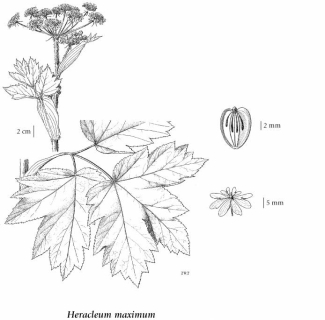cow-parsnip (common cowparsnip)
Apiaceae
Introduction to Vascular Plants
Introduction
Collected once in 1988 by a grassy roadside, Vancouver (Lomer 88-170 @ UBC), but extirpated in 1989.
|
Species Information
General:
Perennial. Stem 1-3 m tall, hairs woolly.
Leaves:
Leaves with widely sheathing petioles 10-40 cm long, upper sheaths enlarged, bladeless, blade 20-50 cm wide, round to kidney-shaped, leaflets 3, 10-40 cm wide, ovate to round, lobed or toothed, usually hairy.
Flowers:
Inflorescence usually 10-20 cm in diameter, woolly or long-hairy, peduncle 5-20 cm long, involucre bracts 5-10, deciduous, narrow, 5-20 mm long, involucel bractlets similar to involucre bracts, rays 15-30, 5-10 cm long. Petals obovate, white.
Fruits:
Fruit 8-12 mm long, obovate to heart-shaped, narrowed toward base, flat, winged, glabrous or hairy.
Account Author:: Fred Ganders, 2010.
Illustration

If more than one illustration is available for a species (e.g., separate illustrations were provided for two subspecies) then links to the separate images will be provided below. Note that individual subspecies or varietal illustrations are not always available.
Illustration Source: The Illustrated Flora of British Columbia
USDA Species Characteristics
Flower Colour:
White
Blooming Period:
Early Summer
Fruit/Seed characteristics:
Colour: Brown
Present over the Summer
Source: The USDA
Ecology
The table below shows the species-specific information calculated from
original data (BEC database) provided by the BC Ministry of Forests and Range.
(Updated August, 2013)
| Site Information |
Value / Class |
||
|
Avg |
Min |
Max |
|
| Elevation
(metres) |
1157 | 0 | 2750 |
| Slope
Gradient (%) |
15 | -5 | 190 |
|
Aspect (degrees) |
140 | 0 | 360 |
| Soil
Moisture Regime (SMR) [0 - very xeric; 4 - mesic; 8 - hydric] |
4 | 1 | 8 |
| Modal
Nutrient Regime
Class |
D | ||
| #
of field plots species was recorded in: |
2723 | ||
| Modal
BEC Zone Class |
ESSF | ||
|
All BEC Zones (# of stations/zone) species was recorded in |
AT(15), BAFA(6), BG(6), BWBS(181), CDF(1), CMA(1), CWH(147), ESSF(955), ICH(286), IDF(90), IMA(3), MH(28), MS(180), PP(3), SBPS(26), SBS(586), SWB(44) | ||
|
Source:
Klinkenberg 2013
|
|||
Habitat and Range
Habitat wet to moist areas from the lowland to the alpine zone. Common throughout BC; amphiberingian, E to NF and S to GA, NM and CA; E. Asia.Status Information
Synonyms
Synonyms and Alternate Names:
Heracleum lanatum Michx.
Heracleum sphondylium subsp. lanatum
Heracleum sphondylium subsp. montanum (Schleich. ex Gaudin) Briq.
Heracleum sphondylium var. lanatum (Michx.) Dorn
Similar Species
To the casual observer, many members of the parsley family (Apiaceae) look similar. Many have white umbels of flowers and dissected leaves. Close inspection, however, shows noticeable differences in leaf shape (amount of dissection), flower (umbel) size, and habitat preferences. When identifying species in this family, habitat should be the first separator (wet or dry sites). In southwestern BC, cow parsnip is most easily confused with smaller plants of giant hogweed (Heracleum mantegazzianum), but may be separated from that species by its generally smaller size, leaf shape (it sports 3 distinct leaflets), and fruit shape. It may also be mistaken for poison hemlock (Conium maculatum). However, poison hemlock is generally much smaller than giant hogweed, with fern-like leaves and smaller flower umbels. Cow parsnip may also be mistaken for other wet-loving members of the Apiaceae, so care should be taken in the identification
|
Taxonomic Keys
1. Leaflets 3; rays of umbel 15-30; fruits narrowed toward base; plants 1-3 m tall ...........H. maximum
1. Leaves ternately or pinnately divided, lateral segments pinnately lobed; rays of umbel 50-150; fruits blunt and rounded toward base; plants 1.5-4.5 m tall.............H. mantegazzianum Source: Key provided by Fred Ganders, 2010 |
Taxonomic Notes
The native cow parsnip can be confused with the alien invasive, giant cow parsnip. Care should be taken with the identification.
|
References
USDA. 2010. Plant profile for Heracleum maximum. United States Department of Agriculture Plants Database. Available Online.